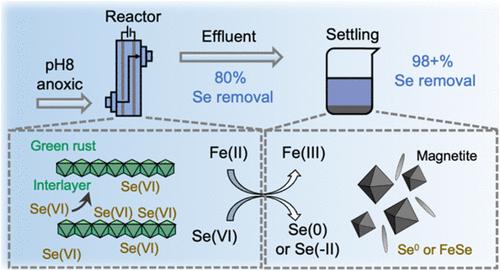连续流式铁电絮凝法去除硒(ⅵ):操作条件和残余固体中硒稳定性的影响
IF 11.3
1区 环境科学与生态学
Q1 ENGINEERING, ENVIRONMENTAL
引用次数: 0
摘要
硒(Se)污染非常普遍,从水中去除硒(VI)尤其具有挑战性。本研究评估了在不同的水化学和操作条件下,在一个直流反应器中使用铁电凝法(EC)去除硒(VI)的情况。在缺氧条件下,铁剂量低至 30 毫克/升,电解反应器停留时间短至 11 秒,然后经过 1 小时的沉淀期,Se(VI)去除率达到 98%(Se 含量为 1000 微克/升)。在较长的运行时间(24 小时)内,去除效果保持稳定,并生成了活性铁(II)/铁(III)固体(绿锈和磁铁矿)。由于污水的 pH 值升高,对硒的吸附有限,因此氧化条件对硒的去除效果较差。固定在固体中的硒以还原形式(-II 或 0)存在,但经过空气暴露后,约 70% 的硒被氧化。尽管硒的还原形式被氧化,但从固体中释放出来的硒却很少,毒性特征浸出程序表明 EC 产生的固体可归类为无害固体。这项研究强调了流经铁质电解槽生产含铁吸附剂和还原剂的潜力,这些吸附剂和还原剂可用于去除硒(VI)和其他氧阴离子。它还为设计有效的处理系统和确保在实际应用中安全处置电解质产生的残留固体提供了实用的见解。本文章由计算机程序翻译,如有差异,请以英文原文为准。

Selenium(VI) Removal by Continuous Flow-Through Iron Electrocoagulation: Effects of Operating Conditions and Stability of Selenium in Residual Solids
Selenium (Se) contamination is widespread, and Se(VI) removal from water is particularly challenging. This study evaluated Se(VI) removal using iron electrocoagulation (EC) in a flow-through reactor under various water chemistry and operating conditions. Effective Se(VI) removal (>98% from 1000 μg/L Se) was achieved under anoxic conditions with an iron dose as low as 30 mg/L and an EC reactor residence time as short as 11 s that was followed by a 1-h settling period. The removal remained stable over an extended operating time (24 h) and involved the generation of reactive Fe(II)/Fe(III) solids (green rust and magnetite). Oxic conditions were less effective for Se removal because of limited Se adsorption at the elevated pH of the effluent. The immobilized Se in the solids was in a reduced form (-II or 0), but about 70% of Se was oxidized after air exposure. Despite the reduced forms of Se being oxidized, very little Se was released from the solids and the toxicity characteristic leaching procedure indicated that EC-generated solids can be classified as nonhazardous. This study highlights the potential of flow-through iron EC to produce iron-containing adsorbents and reductants that can be tailored for Se(VI) and other oxyanion removal. It also offers practical insights into designing effective treatment systems and ensuring the safe disposal of EC-generated residual solids in real-world applications.
求助全文
通过发布文献求助,成功后即可免费获取论文全文。
去求助
来源期刊

环境科学与技术
环境科学-工程:环境
CiteScore
17.50
自引率
9.60%
发文量
12359
审稿时长
2.8 months
期刊介绍:
Environmental Science & Technology (ES&T) is a co-sponsored academic and technical magazine by the Hubei Provincial Environmental Protection Bureau and the Hubei Provincial Academy of Environmental Sciences.
Environmental Science & Technology (ES&T) holds the status of Chinese core journals, scientific papers source journals of China, Chinese Science Citation Database source journals, and Chinese Academic Journal Comprehensive Evaluation Database source journals. This publication focuses on the academic field of environmental protection, featuring articles related to environmental protection and technical advancements.
 求助内容:
求助内容: 应助结果提醒方式:
应助结果提醒方式:


